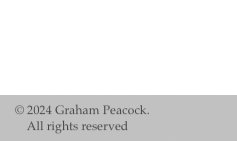 |
 |
||||
Painter pours his new illusions on older onesToronto Star. Dec. 13, 2003 Some painters think big. So does Graham Peacock. But he also likes to pour big. We're talking about globs and globs of acrylic paint poured across his canvases resulting in huge, colour-bursting works — Montrose is more than 5.5 metres long and weighs more than 80 kilos — that seem bigger, brighter and heavier (in all senses) than they are. "They tend to have a massiveness about them but the illusion of the weight is greater than the real weight," says the 58-year-old, British born painter now teaching at the University of Alberta in Edmonton. "In many cases, they weigh no more than any other canvas. Montrose may take three or four people to hang but that's only because of its length." Montrose is part of Peacock's current show, "New New Illusionism," at the New New Painting Museum, located at the rear of 123 Bellwoods Ave. There's a catch, though. Viewing is by appointment only. The number to call is 416-603-4111. The show's title is an extension of the term "new, new painting" Peacock uses to describe what he does, an idea that came to him in the early 1990s after seeing a show in New York billed as "New Painting." Hey, he thought, what that title meant was not really new painting but merely new work from established and familiar artists. What he was doing was a new kind of painting. Sure, his work came out of the hyper painterly style popular in New York in the '90s, with the paintpouring likes of Morris Louis and others. "But I have gone 50 years past that," he says. "I call these the `New New Illusionism' to separate what I'm doing from the old illusions of (Salvador) Dali and (Giorgio) de Chirico. They're influences on my work although I am not painting representational illusion as they are. They take a figure and break it up into its geometric elements and play with the space. My motifs are my own invention. They're abstract. "Montrose, as a title, means a mountain of roses. But it actually refers to an avenue in Victoria, B.C., where I have a house. Often my titles are life-reflective, indicating a state of mind or social issues. The title always occurs in retrospect. I am not trying to illustrate ideas. I'm a painter's painter." 1 Paint shapes: "These are created from cells of paint. I start with a long length of canvas that I divide into these cells of paint versus areas where there's no paint. I pour the paint to create ponds of paint in different layers of colour that's stratified. Then I let it dry to reveal layers of colour showing through other layers of colour. ``By developing this layering process I've been able to create an overall structure, one with high contrast. I use acrylic because it's the material of the day. Besides, if you had 200 gallons of oil paint standing in a solution on your floor, you'd probably never be able to stand up straight. It'd also be a real fire hazard.'' 2 Canvas shapes: "The end shape of any piece is largely due to taking away excess colour, colour that seems superficial to what the work is. I cut away bits according to their colour. With Cézanne, he essentially broke all of nature down into the cone shape, the sphere and the cube. Later, that became the circle, the square and the diagonal. But when I am pouring painting, I am pouring movement." 3 Moon-like surfaces: "I undulate the surface. In a way, I am padding the surfaces from behind with paint to create the illusion I want them to convey. The surfacemshape creates the illusion of a massive volume. I try to paint in such a way as to give a sense of three dimensions to something that's flat and a sense of flatness to something that is in fact three-dimensional." Graham Peacock's "New New Illusionism" is at The New New Painting Museum, 123 Bellwoods Ave, until Jan.15. |
|||||